check oil Citroen DS5 HYBRID4 RHD 2013.5 1.G Owner's Manual
[x] Cancel search | Manufacturer: CITROEN, Model Year: 2013.5, Model line: DS5 HYBRID4 RHD, Model: Citroen DS5 HYBRID4 RHD 2013.5 1.GPages: 380, PDF Size: 13.63 MB
Page 50 of 380
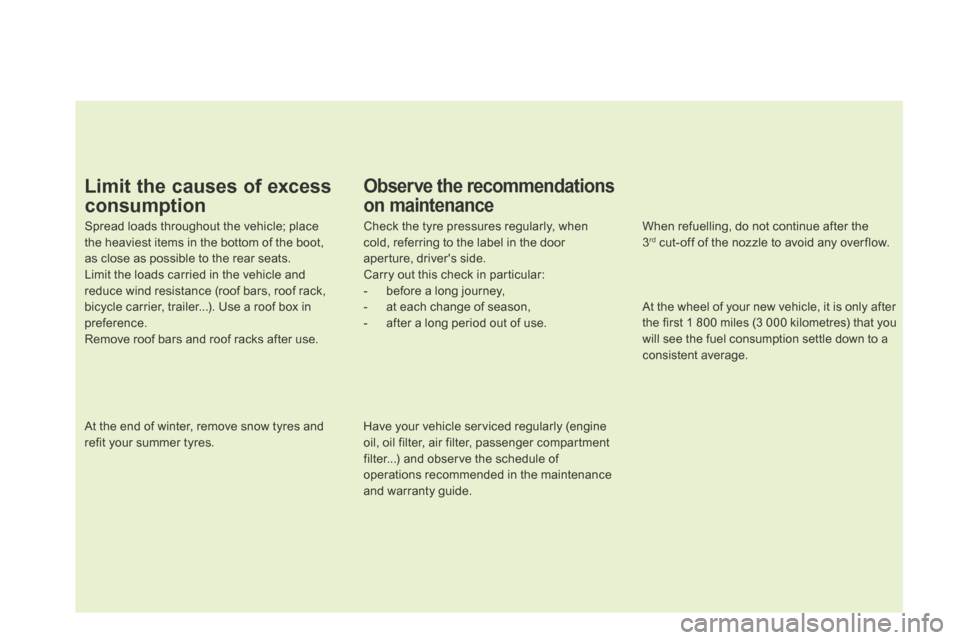
Observe the recommendations
on maintenance
Check the tyre pressures regularly, when cold, referring to the label in the door aperture, driver's side. Carry out this check in particular: - before a long journey, - at each change of season, - after a long period out of use.
Have your vehicle serviced regularly (engine oil, oil filter, air filter, passenger compartment filter...) and observe the schedule of operations recommended in the maintenance and warranty guide.
When refuelling, do not continue after the 3 rd cut-off of the nozzle to avoid any over flow.
At the wheel of your new vehicle, it is only after the first 1 800 miles (3 000 kilometres) that you will see the fuel consumption settle down to a consistent average.
At the end of winter, remove snow tyres and refit your summer tyres.
Spread loads throughout the vehicle; place the heaviest items in the bottom of the boot, as close as possible to the rear seats. Limit the loads carried in the vehicle and reduce wind resistance (roof bars, roof rack, bicycle carrier, trailer...). Use a roof box in preference. Remove roof bars and roof racks after use.
Limit the causes of excess
consumption
Page 75 of 380
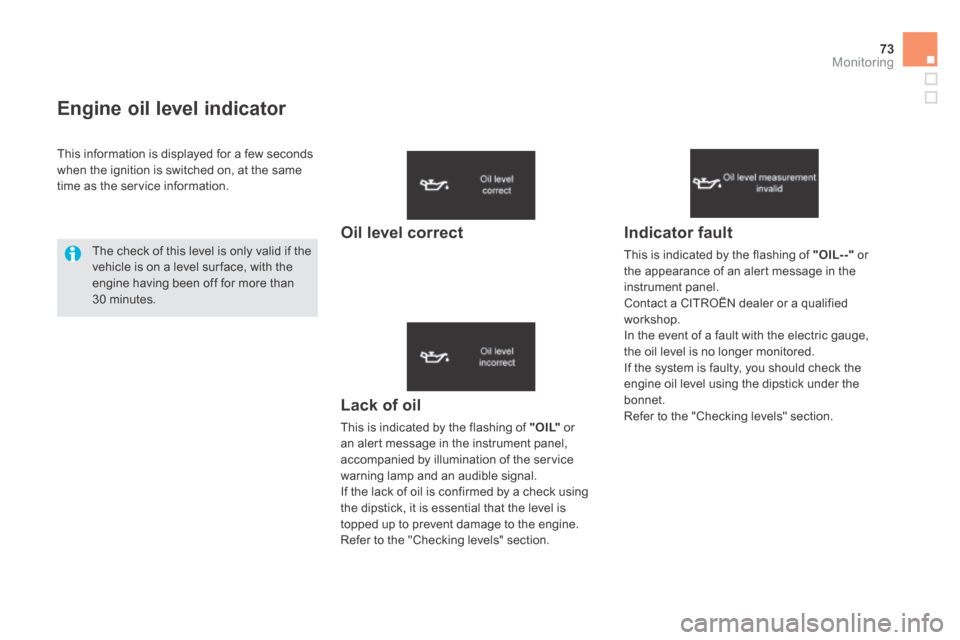
73Monitoring
Engine oil level indicator
Lack of oil
This is indicated by the flashing of " O I L" or an alert message in the instrument panel, accompanied by illumination of the service warning lamp and an audible signal. If the lack of oil is confirmed by a check using the dipstick, it is essential that the level is topped up to prevent damage to the engine. Refer to the "Checking levels" section.
Indicator fault
This is indicated by the flashing of "OIL- -" or the appearance of an alert message in the instrument panel. Contact a CITROËN dealer or a qualified workshop. In the event of a fault with the electric gauge, the oil level is no longer monitored. If the system is faulty, you should check the engine oil level using the dipstick under the bonnet. Refer to the "Checking levels" section.
This information is displayed for a few seconds when the ignition is switched on, at the same time as the service information.
The check of this level is only valid if the vehicle is on a level sur face, with the engine having been off for more than 30 minutes.
Oil level correct
Page 216 of 380
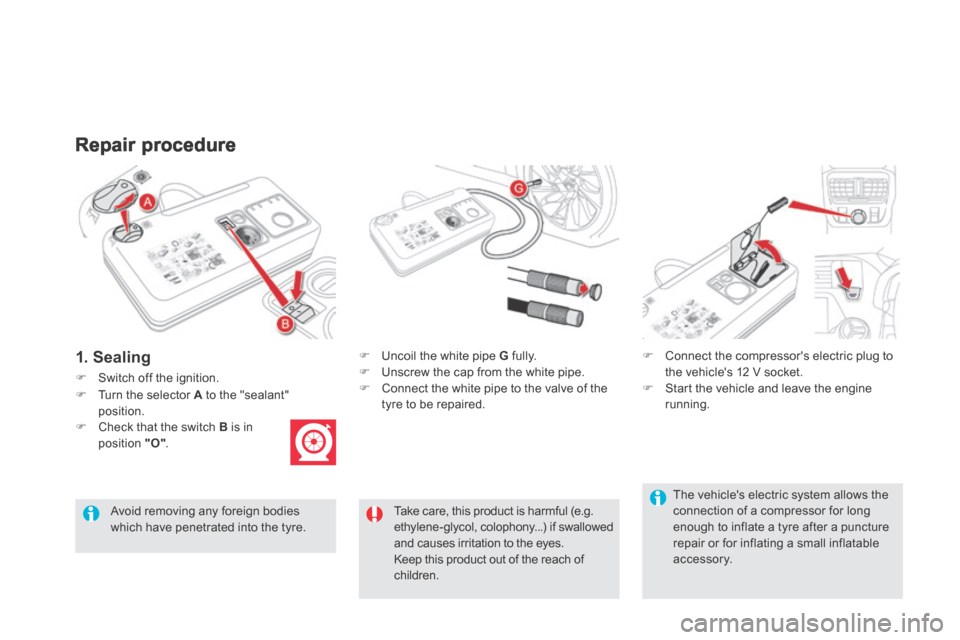
Repair procedure
Switch off the ignition.
Uncoil the white pipe G fully. Unscrew the cap from the white pipe. Connect the white pipe to the valve of the tyre to be repaired.
Connect the compressor's electric plug to the vehicle's 12 V socket. Start the vehicle and leave the engine running.
Take care, this product is harmful (e.g. ethylene-glycol, colophony...) if swallowed and causes irritation to the eyes. Keep this product out of the reach of children.
Avoid removing any foreign bodies which have penetrated into the tyre.
1. Sealing
Turn the selector A to the "sealant" position. Check that the switch B is in position "O" .
The vehicle's electric system allows the connection of a compressor for long enough to inflate a tyre after a puncture repair or for inflating a small inflatable accessory.
Page 219 of 380

217Practical information
Removing the cartridge
Stow the black pipe. Detach the angled base from the white pipe. Support the compressor vertically. Unscrew the cartridge from the bottom.
Beware of discharges of fluid. The expiry date of the fluid is indicated on the cartridge. The sealant cartridge is designed for single use; even if only partly used, it must be replaced. After use, do not discard the cartridge into the environment, take it to an authorised waste disposal site or a CITROËN dealer.
Do not forget to obtain a new sealant cartridge, available from CITROËN dealers or from a qualified workshop.
Checking tyre pressures /
inflating accessories
You can also use the compressor, without injecting any product, to: - check or adjust the pressure of your tyres, - inflate other accessories (balls, bicycle tyres...).
Turn the selector A to the "Air" position. Uncoil the black pipe H fully. Connect the black pipe to the valve of the wheel or accessory. If necessary, fit one of the adaptors supplied with the kit first.
Connect the compressor's electrical connector to the vehicle's 12 V socket. Start the vehicle and let the engine run. Adjust the pressure using the compressor (to inflate: switch B in position "I" ; to deflate: switch B in position "O" and press button C ), according to the vehicle's tyre pressure label or the accessory's pressure label. Remove the kit then stow it.
Page 256 of 380
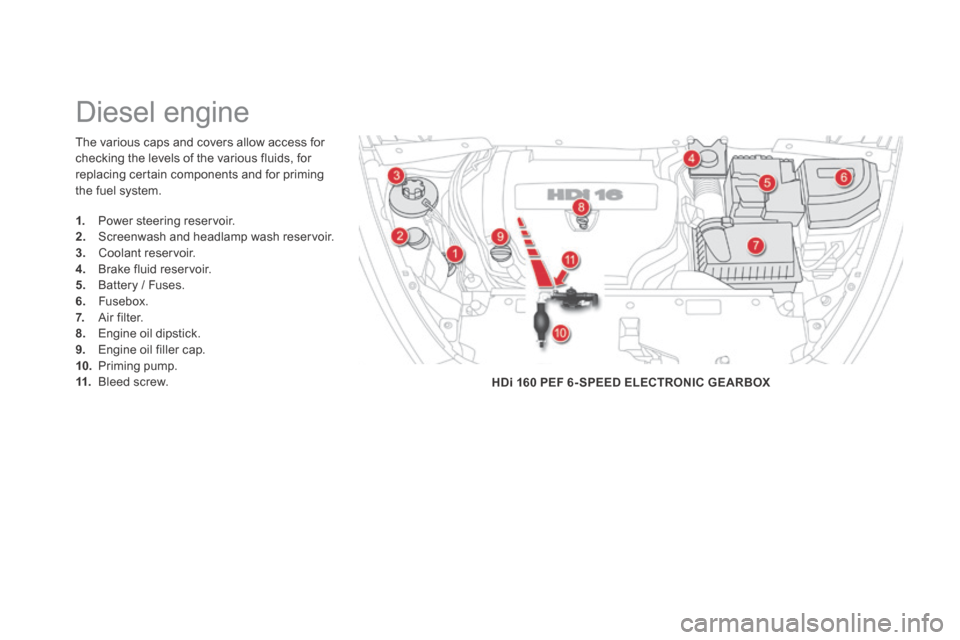
The various caps and covers allow access for checking the levels of the various fluids, for replacing certain components and for priming the fuel system.
Diesel engine
1. Power steering reservoir. 2. Screenwash and headlamp wash reservoir. 3. Coolant reservoir. 4. Brake fluid reservoir. 5. Battery / Fuses. 6. Fusebox. 7. Air filter. 8. Engine oil dipstick. 9. Engine oil filler cap. 10. Priming pump. 11. Bleed screw. HDi 160 PEF 6- SPEED ELECTRONIC GEARBOX
Page 258 of 380
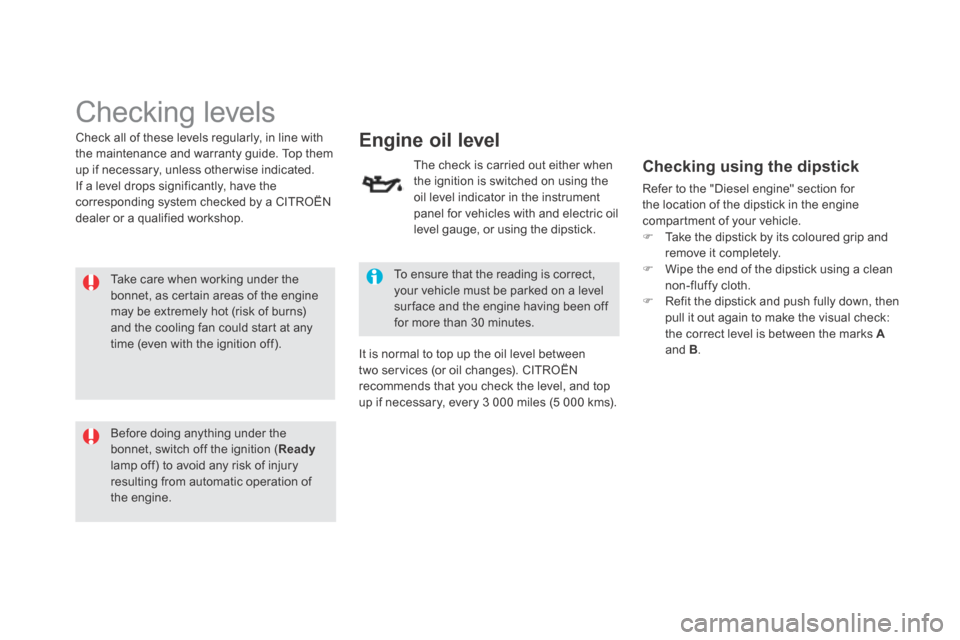
Checking levels
Take care when working under the bonnet, as certain areas of the engine may be extremely hot (risk of burns) and the cooling fan could start at any time (even with the ignition off).
Engine oil level
The check is carried out either when the ignition is switched on using the oil level indicator in the instrument panel for vehicles with and electric oil level gauge, or using the dipstick.
To ensure that the reading is correct, your vehicle must be parked on a level sur face and the engine having been off for more than 30 minutes.
Check all of these levels regularly, in line with the maintenance and warranty guide. Top them up if necessary, unless other wise indicated. If a level drops significantly, have the corresponding system checked by a CITROËN dealer or a qualified workshop.
Before doing anything under the bonnet, switch off the ignition ( Readylamp off) to avoid any risk of injury resulting from automatic operation of the engine.
It is normal to top up the oil level between two services (or oil changes). CITROËN recommends that you check the level, and top up if necessary, every 3 000 miles (5 000 kms).
Checking using the dipstick
Refer to the "Diesel engine" section for the location of the dipstick in the engine compartment of your vehicle.
Take the dipstick by its coloured grip and remove it completely. Wipe the end of the dipstick using a clean non-fluffy cloth. Refit the dipstick and push fully down, then pull it out again to make the visual check: the correct level is between the marks Aand B .
Page 259 of 380

257Checks
A = MA X
B = MIN
If you find that the level is above the A mark or below the B mark, do not star t the engine . - If the level is above the MAX mark (risk of damage to the engine), contact a CITROËN dealer or a qualified workshop. - If the level is below the MIN mark, you must top up the engine oil.
Oil grade
Before topping-up the oil or changing the oil, check that the oil is the correct grade for your engine and conforms to the manufacturer's recommendations.
Topping up the engine oil level
Refer to the "Diesel engine" section for the location of the oil filler cap in the engine compartment of your vehicle. Unscrew the oil filler cap to reveal the filler aperture. Add oil in small quantities, avoiding any spills on engine components (risk of fire). Wait a few minutes before checking the level again using the dipstick. Add more oil if necessary. After checking the level, carefully refit the oil filler cap and the dipstick in its tube.
After topping up the oil, the check when switching on the ignition with the oil level indicator in the instrument panel is not valid during the 30 minutes after topping up.
Engine oil change
Refer to the maintenance and warranty guide for details of the interval for this operation. In order to maintain the reliability of the engine and emission control system, the use of additives in the engine oil is prohibited.
Page 262 of 380
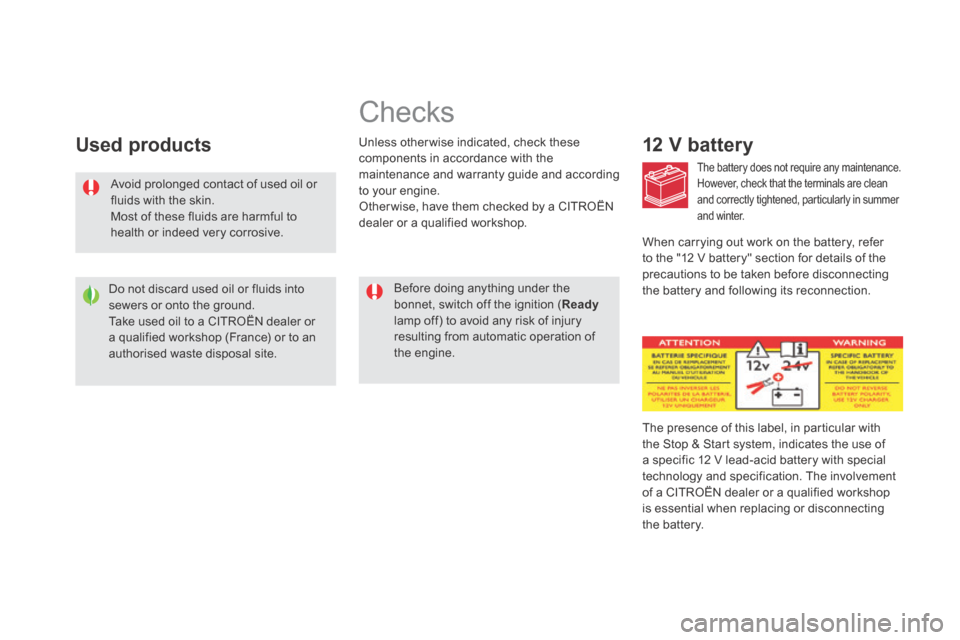
Avoid prolonged contact of used oil or fluids with the skin. Most of these fluids are harmful to health or indeed very corrosive.
Do not discard used oil or fluids into sewers or onto the ground. Take used oil to a CITROËN dealer or a qualified workshop (France) or to an authorised waste disposal site.
Used products
Checks
Unless otherwise indicated, check these components in accordance with the maintenance and warranty guide and according to your engine. Other wise, have them checked by a CITROËN dealer or a qualified workshop.
Before doing anything under the bonnet, switch off the ignition ( Readylamp off) to avoid any risk of injury resulting from automatic operation of the engine.
The presence of this label, in particular with the Stop & Start system, indicates the use of a specific 12 V lead-acid battery with special technology and specification. The involvement of a CITROËN dealer or a qualified workshop is essential when replacing or disconnecting the battery.
12 V battery
The battery does not require any maintenance. However, check that the terminals are clean and correctly tightened, particularly in summer and winter.
When carrying out work on the battery, refer to the "12 V battery" section for details of the precautions to be taken before disconnecting the battery and following its reconnection.
Page 263 of 380
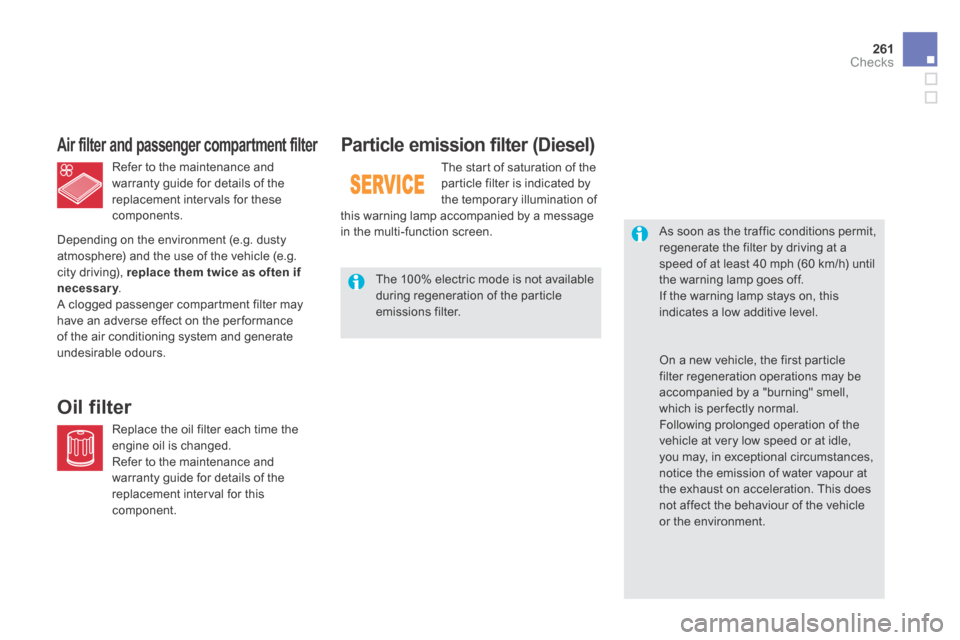
261Checks
Particle emission filter (Diesel)
The start of saturation of the particle filter is indicated by the temporary illumination of this warning lamp accompanied by a message in the multi-function screen. As soon as the traffic conditions permit, regenerate the filter by driving at a speed of at least 40 mph (60 km/h) until the warning lamp goes off. If the warning lamp stays on, this indicates a low additive level.
On a new vehicle, the first particle filter regeneration operations may be accompanied by a "burning" smell, which is per fectly normal. Following prolonged operation of the
vehicle at very low speed or at idle, you may, in exceptional circumstances, notice the emission of water vapour at the exhaust on acceleration. This does not affect the behaviour of the vehicle or the environment.
The 100% electric mode is not available during regeneration of the particle emissions filter.
Air filter and passenger compartment filter
Oil filter
Replace the oil filter each time the
engine oil is changed. Refer to the maintenance and warranty guide for details of the replacement interval for this component.
Refer to the maintenance and warranty guide for details of the replacement intervals for these components.
Depending on the environment (e.g. dusty atmosphere) and the use of the vehicle (e.g. city driving), replace them twice as often if necessary . necessary . necessary A clogged passenger compartment filter may have an adverse effect on the per formance of the air conditioning system and generate undesirable odours.
Page 264 of 380
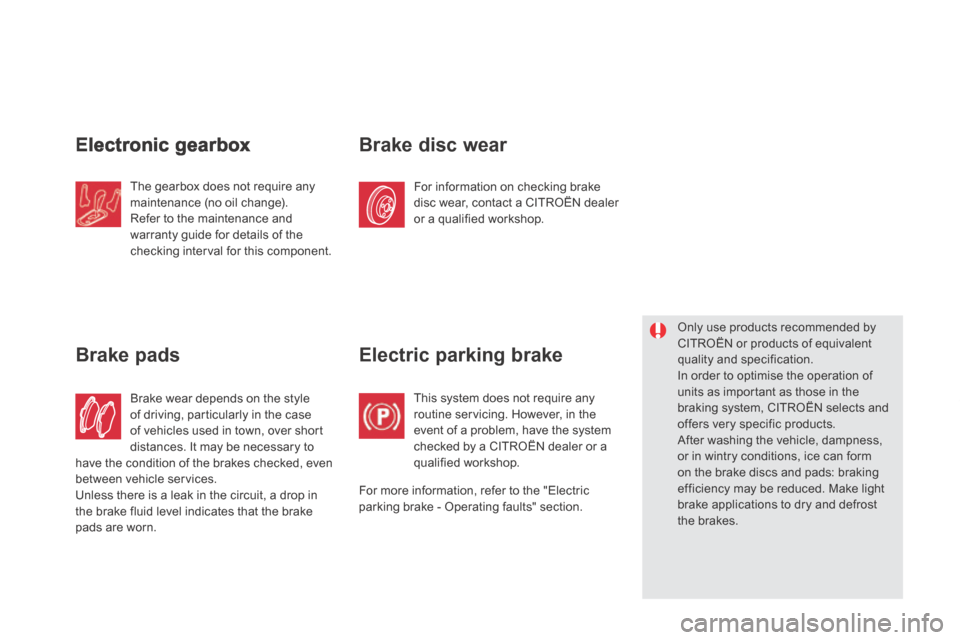
Electronic gearbox
The gearbox does not require any maintenance (no oil change). Refer to the maintenance and warranty guide for details of the checking interval for this component.
Brake wear depends on the style of driving, particularly in the case of vehicles used in town, over short distances. It may be necessary to have the condition of the brakes checked, even between vehicle services. Unless there is a leak in the circuit, a drop in the brake fluid level indicates that the brake pads are worn.
Brake pads
For information on checking brake disc wear, contact a CITROËN dealer or a qualified workshop.
Brake disc wear
Electric parking brake
This system does not require any routine servicing. However, in the
event of a problem, have the system checked by a CITROËN dealer or a qualified workshop.
Only use products recommended by CITROËN or products of equivalent quality and specification. In order to optimise the operation of units as important as those in the braking system, CITROËN selects and offers very specific products. After washing the vehicle, dampness, or in wintry conditions, ice can form on the brake discs and pads: braking efficiency may be reduced. Make light brake applications to dry and defrost the brakes.
For more information, refer to the "Electric parking brake - Operating faults" section.